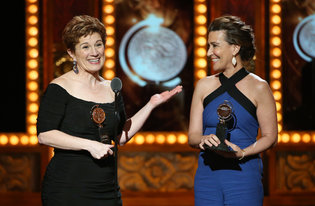Link Roundups feature articles and bits of internet goodness that our dramaturgy team digs up. If you find something you want to send our way, drop us a line on Facebook or Twitter!
♦♦♦♦♦

Lisa Kron, left, and Jeanine Tesori accepting a Tony Award for best score, for their collaboration on “Fun Home.” Credit Sara Krulwich/The New York Times
The New York Times has a story about The Count — a study that tracks the number of female-written productions that are done each year.
Overseen by the playwrights Julia Jordan and Marsha Norman, the study, called “The Count,” is to be updated each year. Until now, besides a handful of older analyses, it had been unclear just how many female playwrights were seeing their work staged, according to Ms. Jordan.
“We wanted to create a baseline,” she said, “and to document the change.”
Judging from the numbers, the picture for women is rosier than a decade ago. A 2002 report from the New York State Council on the Arts found that 17 percent of productions across the country had female playwrights. According to the new report, that figure now sits at 22 percent.
♦♦♦♦♦
The ongoing conversation about the way theatre critics handle race in their reviews is continued in this article by Diep Tran for American Theatre, which gives four ways critics can be less racist:
We theatre journalists are a marginalized minority ourselves: overworked, underpaid, and constantly fighting to justify our existence. We’re not all that different from the artists we claim to love. And if we really love theatre, then we need to find a better way to talk about the diverse people who make it. Because right now, we—whose job it is to tell the truth—are failing at it.
